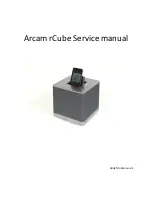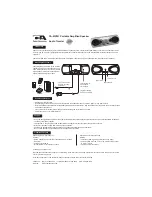
Overview
The
rCube
in
its
simplest
form
can
be
thought
of
as
a
high
performance
iPod
docking
station
with
more
than
a
few
unique
features
these
include.
Wireless
transmission
from
either
iPod
transmitter
(Arcam
Wand)
or
USB
(Arcam
Wave)
these
are
both
optional
extras.
rCubes
can
transmit
to
each
other
from
a
docked
iPod
or
external
source
wired
source.
Internal
battery
power
supply.
Easily
replaceable
iPod
header
(covered
latter
in
manual).
Access
Although
very
compact
the
rCube
is
designed
to
be
serviceable
with
access
gained
from
underneath
to
all
electronic
circuits
(remove
the
four
rubber
feet)
you
will
see
four
Philips
screws,
once
these
are
removed
the
base
plate
can
be
lifted
away
exposing
the
main
circuit
board.
The
main
speaker
array
is
not
considered
a
serviceable
part
but
will
be
available
as
a
complete
assembly.
Please
see
detailed
exploded
view.
Circuit
description
PSU
and
charge
The
19V
D.C
PSU
for
the
rCube
is
derived
from
either
an
external
regulated
PSU
or
if
not
present
from
the
internal
lithium
ion
battery
packs
the
following
is
a
description
of
the
PSU
selection.
The
external
19V
power
supply
is
connected
to
Con600
and
is
internally
fused
by
the
4A
fuse
at
location
FS600
the
rear
panel
switch
can
be
seen
at
location
SW600(a),
D600
is
used
to
prevent
reverse
bias,
D602
and
TR600
from
a
D.C
sense
circuit
this
line
goes
to
the
main
micro
at
location
U301
pin
7.
PSU
selection
is
control
by
the
MAX1873
Switch
mode
Li
charge
controller
at
location
IC603
the
external
19v
source
can
be
seen
to
arrive
at
pin
15
(DCin)
and
when
present
simply
by
‐
passes
the
chip
whilst
being
monitored
by
pins
1/2
(current
sense)
and
can
be
seen
to
form
the
19v
source
net
on
the
diagram.
The
internal
battery
source
can
be
seen
connected
to
CON602
and
again
travels
thru
the
2
nd
pole
of
switches
available
on
SW600(b)
D605
and
TR603
are
used
to
form
simple
logic
to
indicate
to
micro
U301
that
battery
power
is
present,
D606
allows
a
path
to
the
main
19v
net
whilst
preventing
reverse
bias,
the
Mosfet
(M601)
is
used
to
enable
charge
if
necessary
when
power
is
present
–
the
entire
circuit
is
overseen
by
the
main
micro
U301
via



































